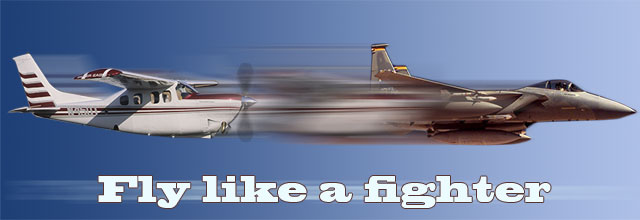
Our F-15 training scenario for the day created a border that we were defending and could not cross. I was the wingman and two other F-15s were playing the role of red air. At one point, the red air fighters made a run toward the border, so we left our holding pattern and made a dash toward them. When eight miles from the red air fighters, and before they crossed the border, they made a 90-degree turn to parallel the border. It was during their turn that I called out a tally on one of them.
 Normally an eight-mile tally on another fighter just didn’t happen. At this range, the apparent size of an F-15 is about half the diameter of a pin head on the canopy. Because I had a radar lock on one of them, I knew where in the sky to look. Also, because of the combination of clouds below the floor of the military operations area and the sun’s position in the sky, the environmental conditions were perfect for me to see the jet at such a long range. As I expected, I didn’t see him for long because as he completed his turn the sun angle changed just enough on his jet that he disappeared. Almost immediately after I called the tally, my flight lead called for a 90-degree turn for us as well, since we could no longer go after them because they hadn’t crossed the border.
Normally an eight-mile tally on another fighter just didn’t happen. At this range, the apparent size of an F-15 is about half the diameter of a pin head on the canopy. Because I had a radar lock on one of them, I knew where in the sky to look. Also, because of the combination of clouds below the floor of the military operations area and the sun’s position in the sky, the environmental conditions were perfect for me to see the jet at such a long range. As I expected, I didn’t see him for long because as he completed his turn the sun angle changed just enough on his jet that he disappeared. Almost immediately after I called the tally, my flight lead called for a 90-degree turn for us as well, since we could no longer go after them because they hadn’t crossed the border.
My concern at this point was that we were also flying parallel to the border, which meant our radars were no longer looking into bad guy territory and I didn’t exactly know where the bandits went. My flight lead was a senior pilot, so I waited in anticipation of our next move. Those moves became reactive as red air started calling out kill shots on us from our rear quarter.
I was a bit perplexed. I didn’t understand why we turned 90 degrees where our radars were pointing the wrong way. In the debrief, my flight lead was just as perplexed. He asked why I hadn’t told him that I lost sight of the bandit. Aha! The only reason he had us turn 90 degrees was that he thought I still had a tally on one of them. I didn’t say anything because I figured he knew how fleeting an eight-mile tally is; plus, the bandits turned, and then we turned, so he had to know that I wouldn’t maintain a tally through all of that, right? Wrong. When I called out a tally, that meant that I visually saw a bandit; the lack of any further calls meant I still saw it. I needed to make a “No Joy” call when I lost sight.
Just last month, while transiting the Dallas Class B airspace on a busy afternoon, I heard approach instruct a Bonanza, “Citation jet your right two o’clock, follow him for a right base to Runway 16.” The Bonanza was on a different frequency so I didn’t hear the response, but when the approach controller started giving instructions to the next aircraft I figured the Bonanza pilot responded in the affirmative. About a minute later, approach control’s transmission was: “Bonanza 123, it looks like you lost sight of the Citation, correct? … OK then, fly heading 090 and let tower know you don’t have sight of the jet you are following. Contact them now on 123.4.”
This sounded like the same debrief I had after the F-15 exercise. If you can’t maintain sight of the aircraft you are told to deconflict with, then don’t make the same mistake I did—speak up.
Larry Brown of Denton, Texas, is a retired Air Force F-15 pilot who is using the lessons he learned as a fighter pilot as a GA pilot in his Cessna P210. Brown, who has 2,900 hours total time during his 35 years of flying, also was an instructor pilot and flight examiner in the Air Force T-38 and instructor pilot in the T-52, the military’s version of GA’s Diamond DA40. See previous installments of “Fly like a fighter.”



